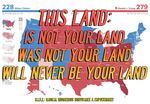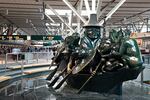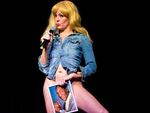Portland hip hop artist Aminé hit the stage of the "Tonight Show" on Tuesday, adding some politics to his track “Caroline.”
"If my president is Trump / then it's relevant enough / to talk better on TV and not give a [gasp]"
His voice joined the chorus of artists protesting in the streets, making visual art about the election, and other kinds of work.
“You can never make American great again / All you did is make this country hate again.”
In fact, many Oregon artists are rethinking what their work has to say in a divisive political season.
"Anything that isn’t contributing to the dialogue is just not worth making right now.”
Demian DinéYazhi is part of a generation of artists who’ve spent their entire professional lives under the Obama administration. His work has always been political, exploring queer theory, indigenous resistance, and more through multimedia, posters, photography, zines and more.
This has been a bruising year.
“With election results,” DinéYazhi said, “also the North Dakota Access Pipeline indigenous resistance, there are all these threats to indigenous, black and brown bodies.”
DinéYazhi says everyone he's interacted with since election day has a shared feeling of instability. "Our realities have been completely shaken up," he said. Donald Trump's election "causes us to question what we consider normal. It causes us to question our complacency."

Demian DinéYazhi: "I feel like anything I was doing before this is completely disrupted. It doesn’t feel as important, somehow."
Courtesy of Demian DinéYazhi
DinéYazhi lives in Portland but is working at a residency this month at the Institute of American Indian Arts in New Mexico.
As an indigenous man, and a gay man, he said every day offers some awful new reality — from the Orlando shootings to Black Lives Matter to every new explosion of rhetoric from the campaign trail.
The accumulated weight of the year, the danger he feels manifests as physical strain. DinéYazhi said he's trying not to live too much in his own head with his fears for the next four years. Right now, he says the discipline that speaks most satisfyingly to him is music.
"Music, poetry, and video," he said. "Leonard Cohen, who just passed away — " 'The Partisan', 'Hallelujah'. Buffy St Marie covered a [Cohen] song called 'God is Alive, Magic is Afoot'." Again and again, he finds his memory calling up a video by the late contemporary artist and activist David Wojnarowicz. "The Fire In My Belly" was famously pulled from an exhibition at the Smithsonian. But its dark, Biblical visions, set to the authoritative growl of singer and performance artist Diamanda Galás.
"The music itself goes to these really dark places. And Diamanda Galás ... personifies this strong persona and character, someone to be reckoned with, as a way to protect herself as a woman walking down American streets."
DinéYazi is thinking through what aspects of his practice speak to people in a radically changed political landscape. This week, the Village Voice published an essay he wrote that explores the links between the Standing Rock protests and Donald Trump's ascendance.

Untitled, 2016.
Ccourtesy of Demian DinéYazhi.
“I’m asking myself what my artwork looks like in the future,” he said. “I’m trying to revisit old photo projects. Any artwork I make that isn’t addressing issues that pertain to politics involved with the presidency, the election of Donald Trump, Standing Rock — anything that isn’t contributing to that dialogue is just not worth making right now.”
Campaign season has been hard for a lot of artists, who generally lean left. But there are nuanced ways to look at the situation.
“We all have to row in this boat.”
Steve Parks has seen some “pretty heavy freaking out in my office recently," he said. "Everywhere from people feeling ecstatic to absolutely depressed."
Parks is the founder of Parks Bronze in the eastern Oregon town of Enterprise and one of the godfathers of the thriving Wallowa County foundry scene. His company makes everything from very modern art to giant bronze eagles that stand watch outside courthouses.
"We did one for [New Mexico sculptor] Dave McGary that's in the capitol rotunda," Parks said. "I saw it on C-SPAN some years ago."
Parks isn’t a Democrat or a Republican. And despair is not one of the emotions he’s feeling this week.

Steve Parks of Parks Bronze says he's considered how the political zeitgeist affects what sculpture gets made. "It’s not easy to pin that down. I know in a Democratically held White House, you see it a little more modernistic art. We’ve seen flurry of projects that are religiously-oriented in the last year or two. That’s been a new thing."
Reuben Unrau / OPB
“I’m pretty thick-skinned,” he said. “I don’t need a lot of help to stay optimistic.” He says he thinks art can offer something soothing for those feeling worn down.
At the same time, Parks said, he finds himself thinking about a work by sculptor Bill Reid that stands in the airport in Vancouver, British Columbia. It's called “The Spirit of Haida Gwaii.”
“It’s one of the most iconic pieces I’ve ever seen,” Parks said. “It describes a lot of different people that make up this world, and they’re all in a boat, rowing together.”
These mythic figures — Bear, Mouse Woman, Raven, Wolf, and others — are crowded into a canoe, a jumble of discord. But Parks said, “That’s what we have to do. We all have to row in this boat.”

"The Spirit of Haida Gwaii: the Jade Canoe" by Haida artist Bill Reid, 1993. The second and final bronze casting. Reid drew on iconic characters from the Haida spiritual tradition to tell a story about coexistence.
Courtesy of YVR Airport.
Parks says, after a few slow years, business has recently picked up again. "It's been tough on a lot of foundries," he said. "A lot of them went out of business, artists quit working." But now he's getting a flurry of calls from people he hasn't heard from in years.
During his 35 years in bronze work, Parks says he's tried to pinpoint what subject matter seems to connect with the political zeitgeist.
"It’s not easy to pin that down," he says. "I know that in [years of ] a Democratically-held White House, you see it a little more modernistic art. A little more free expression."
But in the latest rush of work? "We’ve seen flurry of projects that are religiously oriented in the last year or two," Parks said. "That’s been a new thing."
"There’s nothing I'd rather be doing at this moment than showing this piece."
A lot of artists are rethinking the meaning of work they created before this election year.
Boom Arts is a group that brings in vanguard theater artists to Portland. Artistic Director Ruth Wikler-Luker drew our attention to a Toni Morrison essay making the rounds on social media, affirming the responsibility of artists to go to work in times of dread.
"She talks about one way in which bully leaders get their way is by crushing the imagination," Wikler-Luker said. "It’s the role of art and artists to bring the imagination to the fore."
Last year, as Bernie Sanders challenged Hillary Clinton from the left, Boom hosted feminist performance artist Adrienne Truscott. Her show is called “Adrienne Truscott’s Asking For It: A One-Lady Rape About Comedy Starring Her P—— & Little Else!”

Adrienne Truscott in "Asking For It"
Julieta Cervantes / Boom Arts
This year, Ruth Wikler Luker the executive director of Boom Arts, said it was time to bring the show back.
“Right now,” Luker said, “there’s nothing I'd rather be doing at this moment than bringing Adrienne to Portland and showing this piece. We have a president-elect with 12 allegations of sexual assault against him, and it’s still pretty relevant.”
Truscott uses humor and provocation to get audiences thinking about consent. Wikler-Luker describes the staging, Truscott's "blonde hair and beer and no pants. She’s asking the audience, 'Am I asking for it?'"
This is not escapist entertainment. Although a press release for the show goes so far as to suggest it to audiences as a form of “self-care." Can such a pointed discussion of rape culture realistically be said to reduce trauma?
Luker said we are our own best judges about what work will fortify audience members or make them think.
“I think now is a moment for looking at what is it we already do,” she said, “and what is the role we can play in a newly configured political landscape. What just happened? And where’s the compassion?”
Of course, if you want your election year art to get you outside your comfort zone, you have a lot of options.
Monday evening in Portland, a group of progressive-leaning artists and creatives are getting together at Revolution Hall to talk about how they'll get involved on various issues, including civil rights.
